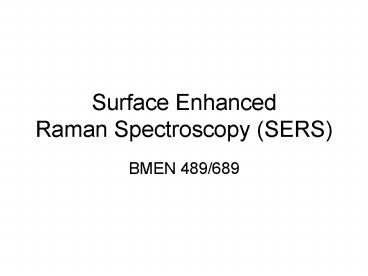Surface Enhanced Raman Spectroscopy SERS - PowerPoint PPT Presentation
1 / 20
Title:
Surface Enhanced Raman Spectroscopy SERS
Description:
Allows 'indirect' probing of vibrational states in molecules. Unique spectral signatures provide means of ... Homonuclear diatomic molecules are Raman active ... – PowerPoint PPT presentation
Number of Views:4436
Avg rating:3.0/5.0
Title: Surface Enhanced Raman Spectroscopy SERS
1
Surface Enhanced Raman Spectroscopy (SERS)
- BMEN 489/689
2
Raman Spectroscopy Review
- Allows indirect probing of vibrational states
in molecules. - Unique spectral signatures provide means of
molecular identification - Used extensively for identification of chemical
constituents in liquid mixtures (i.e. in
petroleum industry) - Can be used in biomedicine as well
3
Optical Activity in Molecules
- Rotational Spectra Molecular system rotates
about axis perpendicular to internuclear axis
(low energy) - Vibrational Spectra Nuclei vibrate about
equilibrium positions (medium energy) - Electronic Spectra Change in electronic
configuration (high energy)
4
Vibrational Spectra
- Quantum mechanics tells us we get discrete states
within the potential well - For parabolic well En (n½)h?0
5
Electronic Spectra
- Optical absorption emission arises from change
in electronic configuration
6
Vibrational Spectroscopy
- Vibrational states can be accessed utilizing two
methods - Infrared Spectroscopy Direct absorption of low
energy light - Raman Spectroscopy Inelastic scattering with
energy transfer to molecule (Stokes Line) or
energy transfer from the molecule (anti-Stokes
Line)
7
Vibrational Spectroscopy
- CO2 Example
- Infrared active is permanent dipole moment
changes as in bending - Raman active if polarizability changes as in
symmetric stretch
8
Vibrational Spectroscopy
- Raman and Infrared spectroscopy are complementary
due to selection rules - Highly symmetric polyatomic molecules with center
of inversion are IR active - Homonuclear diatomic molecules are Raman active
- Non-symmetric molecules demonstrate both
modalities
9
Raman Spectroscopy
- Briefly descend into the math
- Induced dipole
- µind aE0cos(?t)
- Polarizability
- a a0 a1cos(?1t)
- Internal motion modulates the induced dipole
moment - µind a0 E0cos(?t) Rayleigh
- ½ a1E0cos(? - ?1)t Stokes
- ½ a1E0cos(? ?1)t anti-Stokes
10
Raman Spectroscopy
- Both rotational and vibrational states can be
observed but rotational states are difficult to
spectrally separate - Uses inelastic scattering
?
?
Stokes band transfers energy to the molecule
11
Raman Spectrum (Shift)
- Cycloxenane excited at 1064nm
- Spectrum independent of excitation
- Exact peak values depend on molecular conformation
12
Raman Spectroscopy
- Generally, the Raman intensity, IR, can be
written as - However, sR tends to be very small (i.e.
10-30cm2/molecule) - So, we have to use lots of laser power and wait a
long time
13
Surface Enhanced Raman
- In the 1970s, it was observed that rough metal
surfaces produced enhanced Raman signals (up to
106) - Observations
- Required roughened (10-100nm) surface of highly
reflective metals - Raman intensity generally falls off with
increasing vibrational frequency - Raman shifts are sometimes shifted from standard
Raman and new peaks appear
14
Surface Enhanced Raman
- The effect was also observed in metal
nanoparticles (NP) we will use this as the
basis for our explaination
- Recall the dielectric function for a metal
- At resonance for NP
- em -2 eH
15
Surface Field Enhancement
- At resonance, we also observe a field enhancement
at the surface of the NP when in resonance
Kelly et al., J. Chem. Phys. B 107, 668 (2003).
16
Surface Field Enhancement
- So, the particle acts as an antenna and
concentrates the incident field at the
nanoparticle surface can be 10-100x - Can plot the Poynting vector of the incident
radiation and absorption around the sphere
Below resonance, particle polarizes in phase and
thus reduces the field inside and slightly
increases field outside
As resonance, particle polarizes resonantly and
greatly enhances the field at the particle
17
Surface Field Enhancement
- Additionally, the nanoparticle enhances the Raman
scattered field as well can be 10-100x as well - Overall, the Raman signal actually experiences a
surface enhancement proportional to
Can be 108!
18
Field Decay
- If we move away from the surface, the dipole
decay has to be considered - Single molecule
- Monolayer
19
Surface Enhanced Raman
- So what does this tell us?
- Want em to be small (low loss) near the
resonance metals - Because signal depends on both E2laser(?) and
E2Raman(?), as ?-? gets larger, G will get
smaller since the resonance condition is NOT met
at both ? and ?
20
Chemical Enhancement
- When molecules are adsorbed to the surface, their
electronic states can interact with the states in
the metal and produce new transitions - True nature of this still not fully understood






























